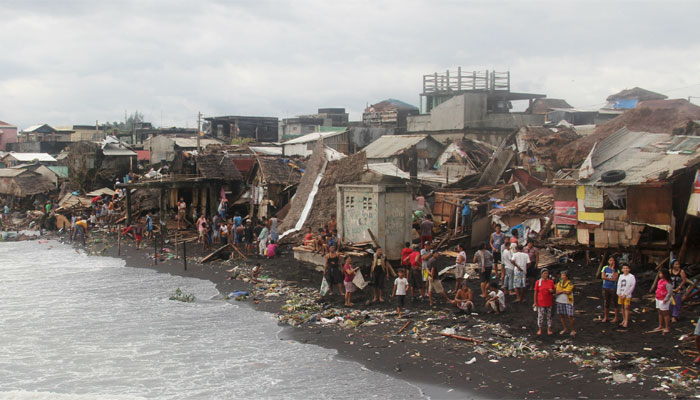Residents sift through the ruins of their houses after strong winds and heavy rains brought by typhoon Melor battered Barcelona town, Sorsogon province, central Philippines. AFP
AFP/Bulan
Tattered lanterns, festive lights and tin roofs littered towns in the central Philippines on Tuesday after Typhoon Melor swept through, killing at least four people and leaving millions without power ahead of Christmas.
Distraught survivors surveyed their damaged homes on the eve of the traditional nine-day Christmas vigil that Filipinos observe with dawn masses and rice cakes.
Christmas is the most celebrated holiday in the Philippines, 80 percent of its 100 million people are Catholic, and decorations such as colourful lights and lanterns had already been put up in most towns.
"It will be a very sad Christmas and a dark one because we have no power. But the important thing is everyone around me is still moving," 54-year-old rice farmer Noemi Pesigan told AFP.
Melor blew out the windows of Pesigan's two-storey brick and wood house in Bulan, a small farming town about 350 kilometres southeast of the capital, Manila, and she survived the storm by sheltering in a nearby shop.
The typhoon tore in off the Pacific Ocean on Monday afternoon and hit farming and fishing communities in the eastern Philippines with winds of up to 185 kilometres (115 miles) an hour.
Three people were killed in floods in Northern Samar province, which faces the Pacific, municipal disaster officer Jonathan Baldo told DZMM radio.
Flying debris also killed a man in Northern Samar, national disaster agency spokeswoman Mina Marasigan told AFP, without being able to confirm the other three fatalities.
Civil defence officials said they were checking reports of additional deaths in isolated areas but were struggling to confirm new casualties due to "communication issues" caused by the storm.
The road out of Bulan was littered with fallen trees and toppled power lines, making travel difficult, while nearby wooden and thatched houses lay in ruin.
Melor weakened slightly as it cut across the central islands of the archipelago, but its wind gusts were still reaching 170 kilometres an hour as it passed over the island of Mindoro Tuesday afternoon.
By evening the typhoon had begun to move out into the South China Sea and based on current forecasts was unlikely to directly hit any further land masses, although a level three storm warning -- the second highest signal -- remained in place for northern Mindoro island.
Dark Christmas
In Bicol, a vast region in the east often hit by typhoons, authorities credited the early evacuation of 720,000 people for what they believed would be a low death toll.
"We have zero floods, zero deaths, zero casualties," Joey Salceda, governor of Albay province in Bicol, told ABS-CBN television.
But he said the entire province of 1.2 million people was without power.
"What we are asking for is the early restoration of electricity," he said.
Residents of neighbouring Sorsogon, which takes in Bulan town, were also without power on Tuesday, and authorities could give no guarantees if electricity would be restored by Christmas.
"Our target is to restore power by Christmas, but it will still depend on many factors," Mina Marasigan, spokeswoman of the national disaster management agency, told AFP.
She said the timing would depend on how badly damaged towns were, and how much cleaning up of roads was required before teams could go in to put up new power poles and lines.
The Philippines is hit by an average of 20 typhoons a year, many of them deadly, with the strongest often happening towards the end of the year.
Last year, 53 people died in floods and landslides after Typhoon Jangmi hit another part of the eastern Philippines five days after Christmas.
The last deadly storm to hit the country this year, Koppu, killed 54 people and forced tens of thousands to flee their homes after it pummelled rice-growing northern provinces in October.
In November 2013, one of the strongest typhoons on record, Haiyan, flattened entire communities in the central region with tsunami-like waves, leaving 7,350 people dead or missing.



